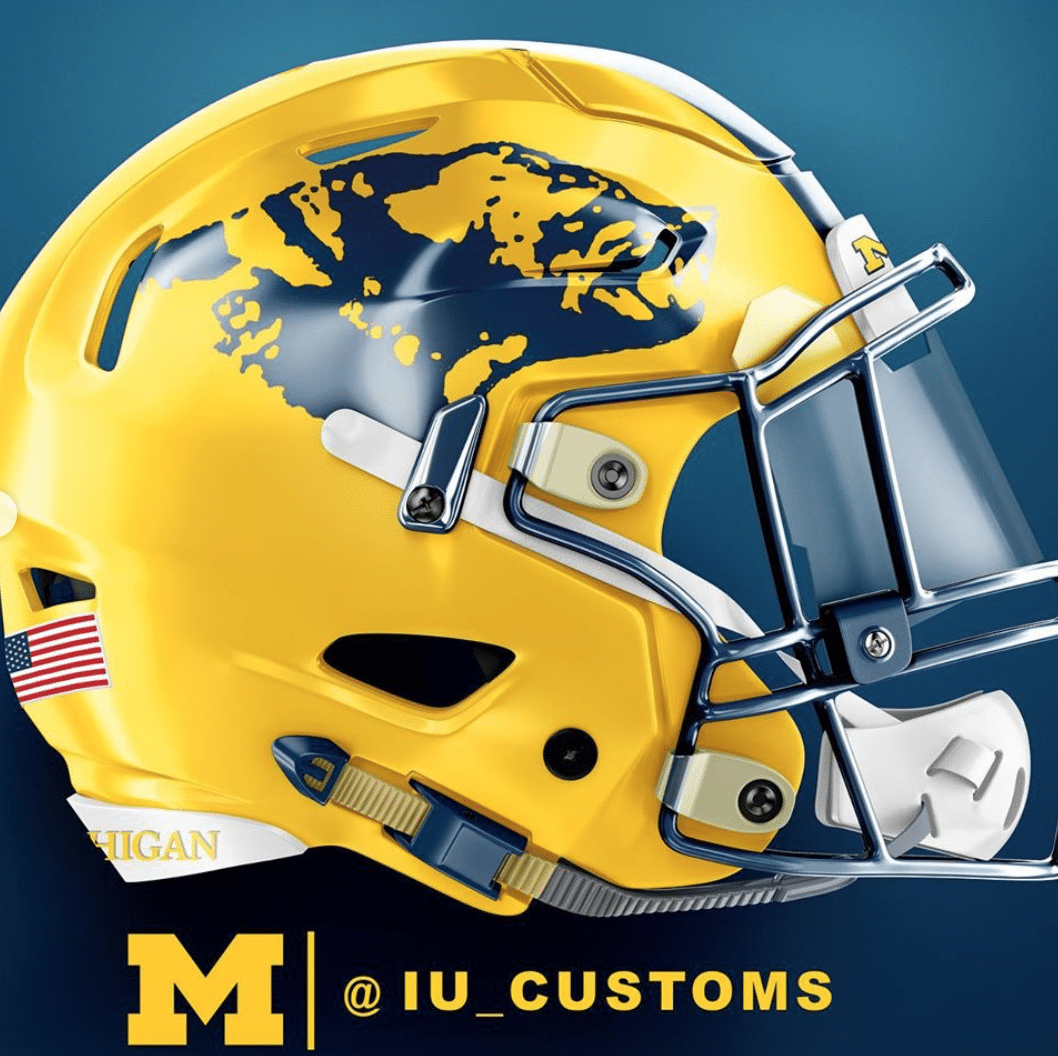Table Of Content

A new football helmet design aims to blunt some dangerous physics that today’s models ignore. Current helmets are made to reduce the peak force of an impact and prevent skull fractures. The new Michigan Engineering system, which is partially funded by the NFL, could lead to a safer helmet. “Fritz” Crisler, was the inventor of the winged helmets when he had his Princeton Tigers football team wear them in 1935. Supporters of this say Crisler created the design to resemble, not wings, but a fighting tiger’s ears flared back.
LOOK: Michigan State football debuts new helmet logo vs. Maryland - Sports Illustrated
LOOK: Michigan State football debuts new helmet logo vs. Maryland.
Posted: Fri, 22 Sep 2023 07:00:00 GMT [source]
Former Michigan football DB re-enters transfer portal
Through all the changes Michigan has preserved the design Crisler imported from Princeton to "dress up" and add a bit of style to Michigan's look. Sophomore halfback Paul Kromer (83) scored the first touchdown wearing the winged helmet and accounted for 13 of Michigan's 14 points in the 1938 win over Michigan State. In this photo from a later game, he leads the blocking for classmate and "Touchdown Twin" Tom Harmon. After winning national titles in 1932 and 1933, Michigan had gone four years without a winning season and team morale had suffered accordingly.
NFL Draft lessons learned: QB decisions
The winged design is a symbol of the team’s tradition and history, but it doesn’t stand for “Ted.” Read about how to attach mouthguard to football helmet. I've been told that when 'MSC' went to the winged helmet, they used the one striped version that could be ordered in the school's colors. No idea why - as far as I know green and white have always been the school's colors. Some accounts of the actual design of the new helmet have sometimes suggested Crisler came up with the idea out of whole cloth. In fact, the previous year Crisler had introduced a helmet at Princeton that should look remarkably familiar to Wolverine fans.
Michigan Wolverines alternate helmet concepts
While it may be hard to see, Michigan added some yellow flakes inside of the maize part of the helmet. The Wolverines also took away the numbers from the side of the helmet.
SEC, Big Ten creating plan to share revenue with players
The Michigan hockey team has gone through almost as many helmet designs as head coaches. The team went hatless in the 1920s, then strapped on leather bowls for the next two decades before switching to plastic boxes, synthetic domes, CCMs, Coopers, and finally Nikes. But the most dramatic change in headgear occurred on an otherwise uneventful day in late February 1989. The Missouri Wolverines Youth Football Program highly recommends all current, new and/or interested football players looking to join the Missouri Wolverines Youth Football Program to attend classes leading up to the fall season. Kansas City Athlete Training has provided training for all sports via speed and agility classes and weightlifting classes plus football training for every position on the field including 1-on-1 personal training since 2005. The origin of arguably the most famous helmet in college football began when coach Fritz Crisler arrived at Michigan in 1938, bringing the look with him from Princeton.
Company, the nation's largest supplier of football equipment, first advertised its model FH5 helmet in the 1937 Official Intercollegiate Football Guide. The distinctive helmet would also have practical advantages on the field. Crisler figured the helmet would help his quarterbacks find receivers downfield.
ANN ARBOR—A shock-absorbing football helmet system being developed at the University of Michigan could blunt some dangerous physics that today’s head protection ignores. A shock-absorbing football helmet system being developed at the University of Michigan could blunt some dangerous physics that today’s head protection ignores. It's a similar-but-different approach to something many teams across college football do, including Ohio State and Georgia. The Wolverines use the stickers to showcase wins, letters and milestones. Here's a look at some of the stickers, their purpose, and what they mean. The Michigan Football helmet is one of the most iconic and recognizable pieces of athletic equipment anywhere in the world - and now it's getting a new addition for the college football playoff.
• It is unknown whether MSU started to wear the winged helmets in 1933 or 1934. Bachman became coach in 1933, so it makes sense that the Spartans started wearing them that season. But the earliest photograph I’ve found of any team wearing the winged helmets is from 1934. Also, the team’s 1933 team portrait (which doesn’t show the helmets) indicates that they had a different uniform in ’33 than in ’34, so they may have had a different helmet as well. Not only did the same coach that introduced the helmet to Princeton bring it to Michigan, but Princeton wasn't even the first school to use a winged helmet design. As I understand it, Crisler's "innovation" was simply to paint the three-striped version in the school's colors.
rZ Designs for Living
The second and third helmets, also known as "alternate color helmets," can only be worn with one of the club's authorized optional uniforms (classic, alternate and/or color rush). In addition, if either alternate color helmet is paired with a classic uniform, the helmet colors and designs must be historically compatible. For decades, many believed the winged helmet was invented by Princeton Coach Fritz Crisler in 1935, who then took the helmets to Michigan in 1938. However, there is more to this history than what was previously thought.
The catcher for the women's softball team proudly wears the winged design on her helmet. Even the swimming team wore the familiar image on its racing caps for a few years. Michigan's football helmet is surely one of the most instantly recognizable icons in college sports.
Whether attributable to the new helmet or not, the passing game improved significantly over 1937's final statistics; total yardage nearly doubled, interceptions were cut nearly in half and completion percentage was up by nine percent. Crisler's first team went on to compile a record and tie for secondin the conference. The maize got a touch brighter, and the blue part of the helmet had a blue matte finish to it. Back in 2012, Michigan had another alternative jersey made to compete in the Outback Bowl against South Carolina. "The two-minute timeout will allow all end-of-half and end-of-game timing rules to be simplified and synch up with this timeout," Steve Shaw, secretary-rules editor, said in a statement. "This will also help broadcast partners to avoid back-to-back media timeouts."
They’ve found medical studies from 70 years back that blame impulse for damage from football-style, quick impacts. Yet today, helmet makers and health researchers alike tend to rely on other factors. For example, new helmet designs are approved based solely on the peak force they can withstand.
Yet the former Michigan football coach and athletic director might be best remembered for designing Michigan's distinctive "winged helmet," still the most recognizable headgear in college football. Football fans all over the world know that the game is not just about what happens on the field. It’s also about the traditions, history, and unique symbols that make each team special.
It represents the team’s long-standing excellence in the sport and connects players and fans to the university’s great football traditions. The post about the helmet stickers reminded me that I needed to post something about the history of the winged football helmet, because the Michigan AD has done such a poor job explaining this in its football guide and on its webpage. Prior to moving in teaching and coaching I worked in sports at ESPN and in the Princeton AD, and I grew up as a Princeton fan in the Lansing area.












